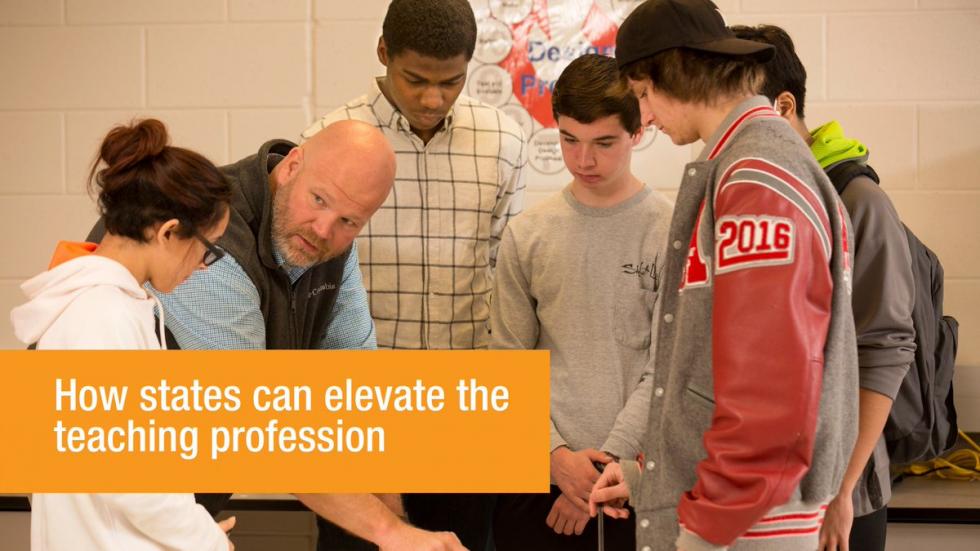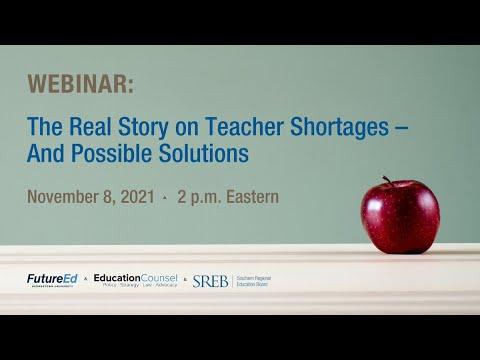WHAT WE KNOW ABOUT TEACHER SHORTAGES — AND HOW STATES, DISTRICTS CAN RESPOND
What do we know about teacher shortages in each state and across the country? How severe are they? What has caused the shortages — and how can leaders help solve them?
SREB joined leaders from EducationCounsel, FutureEd at Georgetown University, and state and local school systems for an online event Nov. 8 to answer these important questions. (See the video of the event at the end of this story.)
Teacher shortages in the South are nothing short of alarming, said SREB’s Megan Boren, who has worked directly with roundtables of education leaders in four states to address teacher shortages.
Most of the 16 SREB states report shortages in math, science, special education, and career-and-technical education teachers, as well as a worsening shortage of world language teachers. Many school districts are even having difficulty finding English-language arts and elementary-grades teachers.
“These shortages are more severe in high-poverty districts or those hard-to-staff districts,” Boren said.
The shortages landscape
There’s also a lack of diversity in teachers’ backgrounds.
Teachers are about 80% white and female, Boren said. In the SREB states, teachers of color range from about 3% of the workforce in West Virginia to nearly 40% in Texas and Florida.
Many school systems report fewer applicants for teacher openings and have become increasingly dependent on uncertified teachers and long-term substitutes to fill school vacancies, said Boren. The number of inexperienced teachers is rising in many states and districts, she said.
“For us, this is not just an education issue. This is an actual workforce issue,” SREB President Stephen Pruitt said. “Without great teachers, we are not going to have a great workforce.”
COVID-19 could make shortages worse moving forward, but the main reasons behind the shortages are clear: relatively low pay, little professional support or respect, few opportunities for career advancement and autonomy, and the lack of teacher incentives and leadership roles.
“Ultimately, we really have to be looking at elevating the profession overall,” she said.
Getting specific about the challenge
Sandi Jacobs, a principal partner at EducationCounsel and author of a new report on teacher shortages with FutureEd, urged researchers and state leaders to analyze data on teacher workforce needs more carefully across states and districts, and within districts, too.
The pipeline of college students entering teacher-prep programs — and those who actually enter the profession — has always been leaky, Jacobs said.
“The leakiest spots are starting to change,” she said. “We need certain kinds of teachers in certain places, with certain skill-sets — and we also need more diversity.”
Tuition assistance and loan forgiveness for teachers in high-need areas have landed states more elementary-grades and social studies teachers, but not enough special education and STEM teachers.
“Ultimately, we really have to be looking at elevating the profession overall,” SREB’s Megan Boren said.
The situation has had a compounding impact on specific geographic areas and subjects and has allowed a continued lack of diversity among teachers to persist — which leaves a substantial talent pool untapped, Jacobs said.
In fact, current approaches may benefit more affluent districts the most. “We really have to think about the equity consequences,” she said.
Bringing the issue home
Tequilla Brownie, the executive vice president of strategy, policy and community coalitions for TNTP, added during the Nov. 8 event that government leaders at the state, federal and local levels also need to see quality teaching as a workforce issue.
States spring into action when a big industry opens, “to make sure there is a viable, trained workforce” and an adequate supply of welders, electricians or other workers, she said. Why can’t the same be true of improving the education system?
“The K-12 sector is trying to solve this problem on its own,” she said.
While the pandemic may end up aggravating teacher shortages, the data don’t show that yet, said Brownie. Based in Arkansas, she formerly led teacher recruitment and support for the Memphis schools.
Even before COVID-19, colleges of education were reporting fewer graduates. Some states have issued waivers for teacher certification and licenses during the pandemic, Brownie said.
“Did that help with quantity? Quality and diversity?” she asked.
“It’s just exacerbating some of the equity challenges that we’ve seen for decades,” she said.
Pursuing new solutions
North Carolina is studying why only about half of its students admitted to education colleges’ teacher-prep programs end up in the profession, said Thomas Tomberlin, the director of educator recruitment and support for the state Department of Public Instruction.
The state once drew about 70% of its teachers from those traditional teacher-prep programs. Now, only one-third come from those colleges. Another one-third enter teaching by switching careers or alternative credentialing, and the remaining third are recruited from outside places such as Michigan, Ohio and Pennsylvania, Tomberlin said.
The teacher-recruitment crisis has raised questions about the quality of educators the state is able to recruit, leading a statewide roundtable of leaders to recommend a major overhaul of the teaching profession in North Carolina.
The roundtable’s plan includes an entirely new approach to teacher licensing, focusing on supporting teachers’ impact on students and their professional growth and leadership roles, Tomberlin said.
“Is the teacher doing great things with kids that we can measure?” he asked.
North Carolina aims to build an “authentic career path allowing teachers to advance, based on demonstrated skill,” he said. The current system relies mainly on teachers’ years of experience and their academic credentials.
New partnerships, bonuses that work
Nancy Wright, the District of Columbia Public Schools’ director of instructional talent acquisition and retention, said her school system has been addressing shortages in real time.
Through a partnership with American University, the D.C. schools offer dual-enrollment courses in education to high school students — and full college scholarships for those who commit to teach in the city for five years. Future teachers do their practicum in the city and continue to receive coaching and professional development from the university.
The D.C. schools also have built up the numbers of teachers of color, establishing a teacher-residency program with Howard University for male teachers. The school district also has recruited school staff members such as teacher-assistants and athletics coaches to complete their degrees and become teachers, Wright said.
A 10-year review of teacher retention strategies in Washington, D.C., shows that hiring bonuses have helped send some of the city’s best educators to work in high-needs schools, she said.
The school system is partnering with the Urban Teachers to certify more teachers in special education across many different subjects, and now has a residency program with Georgetown University on dual languages and English as a second language.
“We’ve been thinking about specifically how to get and keep our educators in the schools where we need them,” Wright said, pointing to signing bonuses of up to $25,000 for teachers in high-need subjects and schools.
Even teachers who decide to leave the D.C. schools can receive a $1,000 bonus if they notify the district by April 1 of their final year, helping schools know where vacancies will occur so they can search for new teachers right away.
Teacher bonuses may not always work, however, said Jacobs, the researcher for EducationCounsel.
Bonuses can be effective for teacher recruitment, but less so for teacher retention, she said. Bonuses in lieu of permanent raises for teachers are “here today, gone tomorrow.”
“I can’t put (that) I’m expecting to get a bonus on my mortgage application,” Jacobs said.
North Carolina has a new program to increase pay by the equivalent of three years for new teachers who score high enough on teacher exams. Teachers of exceptional children (with disabilities and other needs) and STEM teachers can earn even more, Tomberlin said. The program is new, so the results aren’t available yet, he added.
Identifying candidates at home
Another potential strategy for ending shortages: growing more teachers right in your community.
Research suggests that teacher assistants and other school staff members who finish their degrees and enter the profession are more often invested in their local schools already, have more diverse backgrounds and are more prone to stay in those schools for the long term, said Brownie of TNTP.
Career-tech and dual enrollment courses in education can introduce more students to the field and give them a head start in college, added Jacobs of EducationCounsel.
She encouraged states and colleges to examine the content and structure of teacher-prep programs, including whether prospective teachers spend enough time working in real classrooms and learning the joy and value of teaching.
“Is there enough focus on clinical training? Exposure to rural communities and urban communities? New York State requires every teacher to have a practicum experience in the special ed population,” which may encourage more teachers to pursue that area of work, Jacobs said.
Schools also should consider ways to help more teachers of color succeed, Brownie said. Research indicates that cohorts of teachers do better than individuals, for instance.
Historically Black and other minority-serving colleges and universities can be key partners in preparing more diverse teachers, she said, “but by no means are they at the scale to solve the problem.”
Many college students may not be aware of how meaningful a career in education can be, Brownie said.
TNTP found that at Xavier University in New Orleans, which specializes in preparing students of color for medical school and science-related fields, many students didn’t even know an education major was an option.
Some states and school systems are providing scholarships and support to identify potential teachers “from the communities our students are coming from, raising the prospects for the families and caregivers of our students,” Brownie said. “That may help us begin to prioritize this as a community, rather than only as a K-12 issue.”




